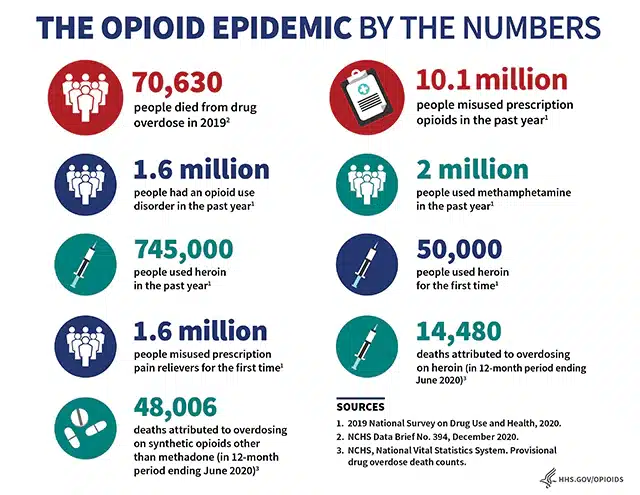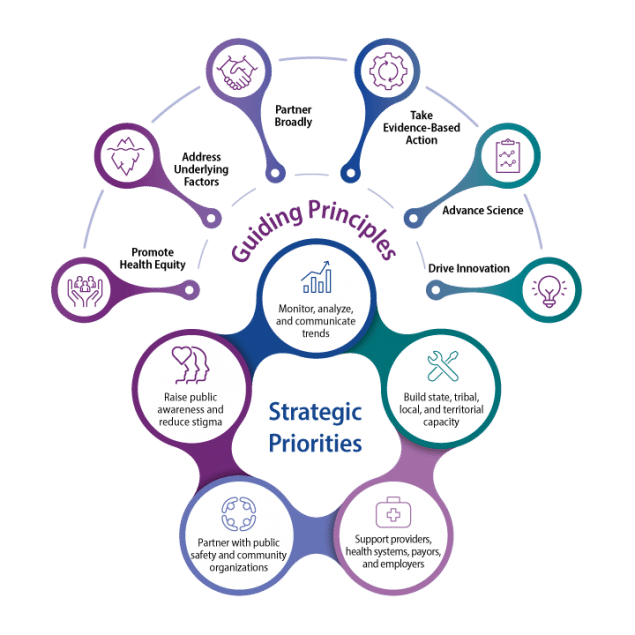Drug overdoses, both fatal and nonfatal, continue to impact our nation.
Overdose deaths remain a leading cause of injury-related death in the United States. The majority of overdose deaths involve opioids. Deaths involving synthetic opioids (largely illicitly made fentanyl) and stimulants (such as cocaine and methamphetamine) have increased in recent years. In addition, overdose deaths accelerated during the COVID-19 pandemic.
For every drug overdose that results in death, there are many more nonfatal overdoses, each one with its own emotional and economic toll. This fast-moving epidemic does not distinguish among age, sex, or state or county lines. People who have had at least one overdose are more likely to have another. If a person who has had an overdose is seen in the ED, there is an opportunity to help prevent a repeat overdose by linking an individual to care that can improve their health outcomes.
Timely data help improve coordination and promote readiness among health departments, community members, healthcare providers, public health, law enforcement, and government agencies, for regional or multiple state overdose increases.
More than 932,000 people have died since 1999 from a drug overdose. In 2020, 91,799 drug overdose deaths occurred in the United States. The age-adjusted rate of overdose deaths increased by 31% from 2019 (21.6 per 100,000) to 2020 (28.3 per 100,000).

In 2020, more than 56,000 deaths involving synthetic opioids (other than methadone) occurred in the United States, which is more deaths than from any other type of opioid. Synthetic opioid-involved death rates increased by over 56% from 2019 to 2020 and accounted for over 82% of all opioid-involved deaths in 2020. The rate of overdose deaths involving synthetic opioids was more than 18 times higher in 2020 than in 2013.
Previous reports have indicated that increases in synthetic opioid-involved deaths have been associated with the number of drug submissions obtained by law enforcement that test positive for fentanyl but not with fentanyl prescribing rates. These reports indicate that increases in synthetic opioid-involved deaths are being driven by increases in fentanyl-involved overdose deaths, and the source of the fentanyl is more likely to be illicitly manufactured than pharmaceutical.
There are also fentanyl analogs, such as acetylfentanyl, furanylfentanyl, and carfentanil, which are similar in chemical structure to fentanyl but not routinely detected because specialized toxicology testing is required. Recent surveillance has also identified other emerging synthetic opioids, like U-47700. Estimates of the potency of fentanyl analogs vary from less potent than fentanyl to much more potent than fentanyl, but there is some uncertainty because potency of illicitly manufactured fentanyl analogs has not been evaluated in humans. Carfentanil, the most potent fentanyl analog detected in the U.S., is estimated to be 10,000 times more potent than morphine.
Addressing the overdose crisis requires partnering with multiple sectors and organizations within all of CDC’s strategic priorities. Partnerships provide opportunities to develop, coordinate, and implement targeted strategies to prevent harm. CDC is dedicated to broad and diverse partnerships as a foundation of preventing overdose and substance-use related harms.
To better address the overdose crisis, CDC promotes strategies that have been extensively researched by scientists. Evidence-based action ensures the delivery (or implementation) of effective methods for preventing and reducing overdose and substance use-related harms that are translated and adapted for diverse audiences and settings.
Continuing to build the evidence-base for what works to prevent overdose and substance-use related harms is critical to ending the overdose crisis. By advancing science through supporting public health surveillance, identifying risk and protective factors, developing and evaluating prevention strategies, and ensuring effective communication strategies that are adapted for diverse audiences, CDC is committed to building the evidence-base for what works to end the overdose crisis.
The overdose crisis will require new and innovative ideas to prevent overdose and substance use-related harms. CDC promotes the generation, implementation, evaluation, and widespread adoption of innovative ideas to address the overdose crisis in all areas of its work.

Contact Amazonite Today
Amazonite Treatment Center cultivates a safe, comfortable environment for patients and families across California to be emotionally connected to their treatment provider. Our recovery management and alumni programs support a life-long recovery. Your journey to recovery doesn’t end with day treatment or outpatient, once you’re with Amazonite, you’re always with Amazonite.
Please note that the information contained within this website is provided for informational and educational purposes only. The use of this website does not imply nor establish any type of doctor/patient relationship. No diagnosis or treatment is being provided by the use of this website. The use of this website does not constitute nor offer any specific mental health or medical advice whatsoever to anyone and is not intended for that use. This website takes no responsibility with regards to misinterpretation of the information provided within this website or any consequences resulting from the use of this website. This website takes no responsibility for any websites that may be linked to this website nor imply any relationships or endorsements to any linked website.